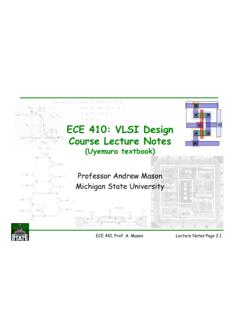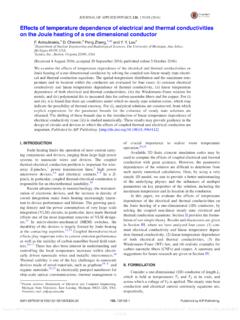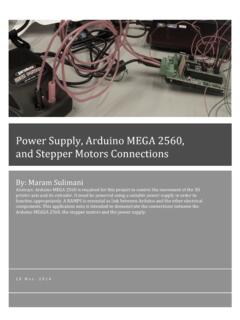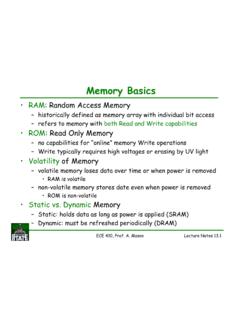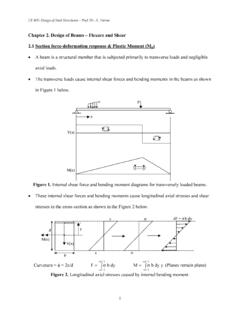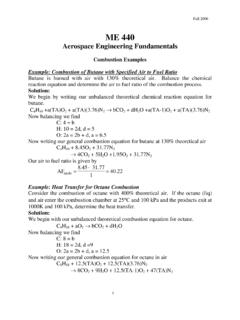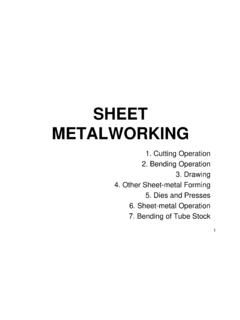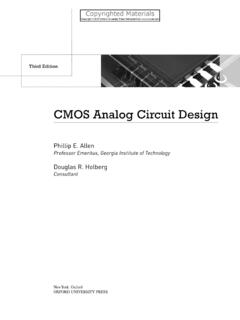Transcription of Review: CMOS Logic Gates - Michigan State University
1 ECE 410, Prof. A. MasonLecture Notes Page : cmos Logic Gates NOR Schematicxxyg(x,y) = x yxxyg(x,y) = x + y NAND Schematic parallel for OR series for AND INV Schematic+Vgs-VoutVinpMOSnMOS+Vsg-= Vin cmos inverts functions cmos Combinational Logic use DeMorgan relations to reduce functions remove all NAND/NOR operations implement nMOS network create pMOS by complementing operations AOI/OAI Structured Logic XOR/XNOR using structured logicECE 410, Prof. A. MasonLecture Notes Page : XOR/XNOR and TGs Exclusive-OR (XOR) a b = a b + a b Exclusive-NOR a b = a b + a b Transmission Gates MUX Function using TGsbabaXOR/XNOR in AOI Formy = x s, for s=1F = Po s + P1 sECE 410, Prof. A. MasonLecture Notes Page Technology Properties of microelectronic materials resistance, capacitance, doping of semiconductors Physical structure of cmos devices and circuits pMOS and nMOS devices in a cmos process n-well cmos process, device isolation Fabrication processes Physical design (layout) layout of basic digital Gates , masking layers, design rules LOCOS process planning complex layouts (Euler Graph and Stick Diagram)Part I: cmos TechnologyECE 410, Prof.
2 A. MasonLecture Notes Page Circuit Layers Integrated circuits are a stack of patterned layers metals, good conduction, used for interconnects insulators(silicon dioxide), block conduction semiconductors(silicon), conducts under certain conditions Stacked layers form 3-dimensional structures Multi-layer metals background assumed to besilicon covered by silicon dioxidesiliconsilicondioxidePart I: cmos TechnologyECE 410, Prof. A. MasonLecture Notes Page Parasitics Parasitic = unwanted natural electrical elements Metal Resistance metals have a linear resistance and obey Ohm s law V = IR generate parasitic interconnect resistance, Rline Rline= l= l A = wt = resistivity, = conductivity defined by sheet resistance Rs = 1 = , resistance per unit length [ohms, ] Rline= Rsl, Rs determined by process, l & wby designer AAltw ttwRline = Rswhenl = w Part I: cmos TechnologyECE 410, Prof.
3 A. MasonLecture Notes Page Resistance: Measuring squares From top view of layout, can determine how many squares of the layer are present square is a unit length equal to the width Rline= Rs n, where n = l is the number of squares Get a unit of resistance, Rs, for each square, = 8 Part I: cmos TechnologyECE 410, Prof. A. MasonLecture Notes Page Line Capacitances Capacitor Basics Q = CV, C in units of Farads [F] I = C dV/dt Parallel plate capacitance Cline= oxwl[F], w l = Area ox= permittivity of oxide ox= o o= [F/cm] RC time constant ofan interconnect line = RlineClinetoxPart I: cmos TechnologyECE 410, Prof. A. MasonLecture Notes Page Properties of Silicon Silicon is a does it conduct or insulate? doping= adding impurities (non-silicon) to Si: will be covered later doping concentration and temperature determine resistivity Conduction/Resistance generally, the Si we see in cmos is doped at room temp.
4 , doped silicon is a weak conductor= high resistance Capacitance doped, room temp. Si is conductive conduction free charge carriers no electric field no capacitance(within bulk silicon) exception: if free carries are removed ( , depletion layer of a diode) silicon becomes an insulator with capacitancePart I: cmos TechnologyECE 410, Prof. A. MasonLecture Notes Page in Semiconductors -Review Intrinsic (undoped) Semiconductors intrinsic carrier concentration ni= , at room temp. n = p = ni, in intrinsic (undoped) material n number of electrons, p number of holes mass-action law, np = ni2applies to undoped and doped material Extrinsic (doped) Semiconductors dopantsadded to modify material/electrical propertiesPBPB++++--group Velementgroup IIIelementionelectronholen-type Donorp-type Acceptorionfreecarrierfreecarrier n-type (n+), add elements with extra an electron Nd conc.
5 Of donoratoms [cm-3] nn= Nd, nn conc. of electrons in n-type material pn= ni2/Nd, using mass-action law, pn conc. of holes in n-type material always a lot more n than p in n-type material p-type = p+, add elements with an extra hole Na concentration of acceptoratoms [cm-3] pp= Na, pp conc. of holes in p-type material np= ni2/Na, using mass-action law, np conc. of electrons in p-type material always a lot more p than n in p-type materialPart I: cmos TechnologyECE 410, Prof. A. MasonLecture Notes Page in Silicon Devices doping provides free charge carriers, alters conductivity conductivityin semic. w/ carrier densities nand p = q( nn+ pp) q electron charge, q= [Coulombs] mobility [cm2/V-sec], n 1360, p 480 (typical values in bulkSi) in n-type region, nn>> pn q nnn in p-type region, pp>> np q ppp resistivity, = 1/ Can now calculate the resistance of an n+ or p+ region n> pelectrons more mobile than holesconductivity of n+ > p+Mobility often assumed constantbut is a function of Temperature and Doping ConcentrationPart I: cmos TechnologyECE 410, Prof.
6 A. MasonLecture Notes Page Gate Operation Gate Capacitance gate-substrate parallel plate capacitor CG= oxA/tox[F] ox= o o= [F/cm] Oxide Capacitance Cox = ox/tox[F/cm2] CG= Cox AG[F] AG=gate area = L W [cm2] Charge on Gate, +Q, induces charge -Q in substrate channel channel charge allows conduction between source and drainchannel= substrate region under the gate, between S and DPart I: cmos TechnologyECE 410, Prof. A. MasonLecture Notes Page n/pMOS Devices nMOS and pMOS cross-section Layers substrate, n-well, n+/p+ S/D, gate oxide, polysilicon gate, S/D contact, S/D metal Can you find all of the diodes (pn junctions)? where? conduct in which direction? what purpose?lightly dopedp regionlightlydopedn regionhighlydopedn regionhighlydopedp regionPart I: cmos TechnologyECE 410, Prof. A. MasonLecture Notes Page cmos Layers Visible Features p-substrate n-well n+ S/D regions p+ S/D regions gate oxide polysilicon gate Mask Layers n-well active(S/D regions) active = not FOX n+doping p+doping polypatterning gate oxide aligned to gate poly, no oxide maskpolyn-welln+p+activePart I: cmos TechnologyECE 410, Prof.
7 A. MasonLecture Notes Page Realization of a 4-Terminal MOSFETs nMOS Layout gate is intersection of Active, Poly, and nSelect S/D formed by Active with Contact to Metal1 bulk connection formed by p+ tap to substrate pMOSL ayout gate is intersection of Active, Poly, and pSelect S/D formed by Active with Contact to Metal1 bulk connection formed by n+ tap to nWell Active layer in lab we will use nactiveand pactive nactive should always be covered by nselect pactive should always be covered by pselect nactive and pactive are the same mask layer (active) different layout layers help differentiate nMOS/pMOSGateDSBulkGroundGateDSBulkVDDPa rt I: cmos TechnologyECE 410, Prof. A. MasonLecture Notes Page Device Dimensions Physical dimensions of a MOSFET L = channel length W = channel width Side and Top viewsPart I: cmos TechnologyECE 410, Prof.
8 A. MasonLecture Notes Page cmos Layers Cover lower layers with oxide insulator, Ox1 Contacts through oxide, Ox1 metal1 contacts topoly and active Metal 1 Insulator Ox2 Via contacts Metal 2 Repeat insulator/via/metal Full Device Illustration active poly gate contacts (active & gate) metal1 via metal2only Metal 1 hasdirect contactto lower layersPart I: cmos TechnologyECE 410, Prof. A. MasonLecture Notes Page Cross Section View Cross section of a 2 metal, 1 poly cmos process Layout (top view) of the devices above (partial, simplified)Typical MOSFET Device (nMOS)Part I: cmos TechnologyECE 410, Prof. A. MasonLecture Notes Page Layout Features VDD & Ground rail using Metal1 layer N-well region for pMOS Active layers different n+ and p+ Contacts n+/p+ to metal poly to metal Alternate layout advantage simple poly routing disadvantage harder to make W largeverticalpolyhorizontalpolyPart II: Layout BasicsECE 410, Prof.
9 A. MasonLecture Notes Page Layout Layers Mask layers for 1 poly, 2 metal, n-well cmos process Background: p-substrate nWell Active (nactive and pactive) Poly pSelect nSelect Active Contact Poly Contact Metal1 Via Metal2 Overglass See supplementary power point file for animated cmos process flow should be viewed as a slide show, not designed for printingPart II: Layout BasicsECE 410, Prof. A. MasonLecture Notes Page MOSFET Layout Series txs 2 txs share a S/D junction Multiple series transistors draw poly Gates side-by-sidePart II: Layout BasicsECE 410, Prof. A. MasonLecture Notes Page MOSFET Layout Parallel txs one shared S/D junction with contact short other S/D using interconnect layer (metal1) Alternate layout strategy horizontal gatesPart II: Layout BasicsECE 410, Prof. A. MasonLecture Notes Page Layouts One layout option with horizontal transistors (L runs horizontally) ignore the size (W) for now2-input NANDpMOS2 parallel txnMOS2 series txs2-input NORpMOS2 series txnMOS2 parallel txsPart II: Layout BasicsECE 410, Prof.
10 A. MasonLecture Notes Page Cell Definitions Cell Pitch = Height of standard cellsmeasured between VDD & GND rails A: 410 lab definition top of VDD to bottom of GND B: interior size, without power rails C: textbook definition middle of GND to middle of VDD Cell Boundarymax extension of any layer (except nwell) set boundary so that cells can be placed side-by-side without any rule violations extend power rails (or 2 to be safe) beyond any active/poly/metallayers extend n-well to cell boundary (or beyond) to avoid breaks in n-wellVDD!GND!ABCVDD!GND!cell boundaryPart II: Layout BasicsECE 410, Prof. A. MasonLecture Notes Page Layout Guidelines Internal Routing use lowest routing layer possible, typically poly and metal1 keep all possible routing inside power rails keep interconnects as short as possible Bulk (substrate/well) Contacts must have many contacts to p-substrate and n-well at least 1 for each connection to power/ground rails consider how signals will be routed in/out of the cells don t block access to I/O signals with substrate/well contacts S/D Area Minimization minimize S/D junction areas to keep capacitance low I/O Pads Placement: must be able to route I/O signals out of cell Pad Layer.

